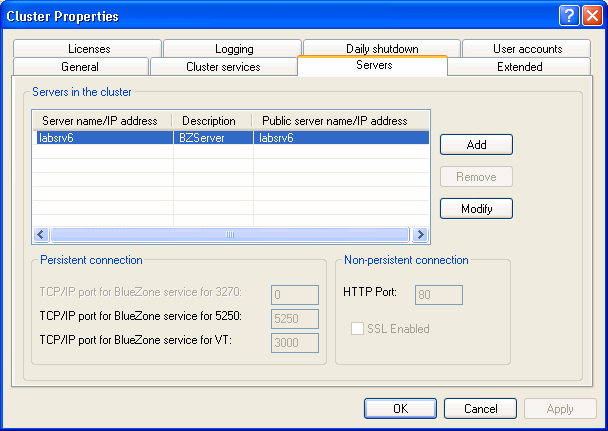Servers tab
In this tab you can add, remove and modify the Server entries in the cluster.

To add a server, click Add to open the New Server dialog box.

Enter the following information in the New Server dialog box:
| 1. | In the Server name or IP field enter the IP address (or DNS name) of the server on which the server will run. |
| 2. | In the Server public name or IP field enter the public IP address (or DNS name) of the server on which the server will run. The public name or IP address of a server is the name or IP address that the users can access from behind a firewall or a DNS server. If you are not using either of thee, then enter in this field the same value that you entered in the Server name or IP field above. |
| 3. | In the Description field enter a descriptive name to make it easier for you to remember the definition. |
| 4. | If you are using active FTP with your host, you must configure the Active FTP section for each server that you will use. Active FTP settings are available for two emulation types (5250 and 3270). For each type, enter the return IP address and port that you want to use for Active FTP sessions. |
| 5. | When you click OK, HAM tries to communicate with the given server (using the IP address) instructing it to register itself with the cluster.
If the operation succeeds, you will see the added server in the list after the dialog box closes. If the operation fails,
check that:
|
Note
Once you have defined (or added) a machine as a server, you cannot add this machine to another cluster as a server of the
same type. If you want to change the role of the machine, first remove it from its original cluster. Note however that HostFront
Server and BlueZone Access Server can co-exist on the same server machine independently (example: the same server machine
can belong to one HostFront cluster and to another BlueZone Access Server cluster at the same time, but not to two HostFront
clusters or two BlueZone Access Server clusters).
Persistent communication port
If you selected the Persistent communication option during the installation of the software, you need to define the persistent
(TCP/IP) port that will be used.
You can define one persistent port for each of your emulation products (3270, 5250 or VT). That is, you must define a different
port for each product type.
The persistent port defined here will be used on all the servers of the same type (For example, if you define port 5250 for
the 5250 service, all the 5250 servers in the cluster will use that port).
Non-persistent communication port
In the Non-persistent connection section you define the HTTP or HTTPS port that will be used by the cluster services to communicate
with the servers. By default, the HTTP port is 80. If you select the SSL enabled check box, the default value becomes 443.
You can always change these values according to your web server settings.
Note
For changes to port numbers or server addresses to take effect you must restart all cluster services.